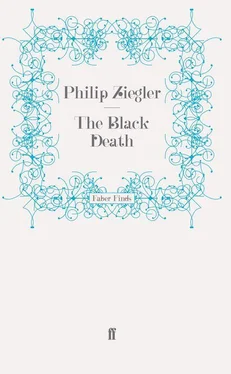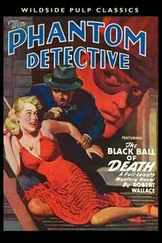It would have been astonishing if he had found many others to share his opinions. Even in the materialistic and, at a certain level, sophisticated nineteen-sixties the apocalyptic vision of a world about to incur destruction through its own folly and wickedness is by no means lost. Man-made devices may have been substituted for the pestilential hammer of the Middle Ages but both methods can be and are interpreted as manifestations of God’s inscrutable workings.
How far more certain it was that the credulous and superstitious citizens of fourteenth-century Europe, unable to see any natural explanation of this sudden and horrifying holocaust, believing without question in hell-fire and the direct participation of God in life on earth, well-versed in Old Testament precedents for the destruction of cities or whole races in a sudden access of divine indignation, would take it for granted that they were now the victims of God’s wrath. Like the citizens of Sodom and Gomorrah they were to die in expiation of their sins. ‘Tell, O Sicily, and ye, the many islands of the sea, the judgements of God! Confess, O Genoa, what thou hast done, since we of Genoa and Venice are compelled to make God’s chastisement manifest!’ {63} 63 20 de Mussis, op. cit., p. 50.
The Europeans were possessed by a conviction of their guilt. They were not so sure of what, exactly, they were guilty but the range of choice was wide. Lechery, avarice, the decadence of the church, the irreverence of the knightly classes, the greed of kings, the drunkenness of peasants; each vice was condemned according to the prejudices of the preacher and presented as the last straw which had broken the back of God’s patience.
‘In those days,’ wrote the English chronicler, Knighton,
there was much talk and indignation among the people because, when tournaments were held, in almost every place, a band of women would arrive as if they had come to join the sport, dressed in a variety of the most sumptuous male costumes. They used to wear partly-coloured tunics, one colour or pattern on the right side and another on the left, with short hoods and pendants like ropes wound round their necks, and belts thickly studded with gold and silver. They were even known to wear those knives which are called ‘daggers’ in the vulgar tongue in pouches slung across their bodies; and thus they rode on choice war horses or other splendid steeds to the place of tournament. There and thus they spent or, rather, squandered their possessions, and wearied their bodies with fooleries and wanton buffoonery… But God, in this matter, as in all others, brought marvellous remedy… {64} 64 21 Chronicon Henrici Knighton, R.S. 92, ii, pp. 57–8.
Knighton was something of a conservative. Though many others might have condemned the current fashions, only a few would have called the Black Death a ‘marvellous remedy’ or have believed that God was being entirely temperate in his retribution when he obliterated quite so many to punish the extravagance of a few. But his conviction of the immorality of the age was wide-spread. ‘These pestilences were for pure sin’ wrote Langland sadly and more comprehensively. {65} 65 22 Piers Plowman, Version B, v. 13.
None of those who believed that the plague was God’s punishment of men suggested that the punishment did not fit the crime. God’s will had to be done, his vengeance wreaked, and it was for man blindly to accept. To question His justice would have been a fresh and still more heinous sin, inviting yet further chastisement from on high.
Looking back, the victim of the Black Death saw a host of portents which should have warned him of God’s intentions. Simon of Covino noticed heavy mists and clouds, falling stars, blasts of hot wind from the South. A column of fire stood above the papal palace at Avignon and a ball of fire was seen in the skies above Paris. In Venice a violent earth tremor set the bells of St Mark’s pealing without touch of human hand. Anything which seemed in the least out of the way was retrospectively identified as a herald of the plague: a stranded whale, an outstandingly good crop of hazel nuts. Blood fell from bread when taken freshly from the oven. An illustration of the way that a legend could build up came in a later epidemic when mysterious bloodstains were found on men’s clothes. Subsequent examination showed that the stains were in fact caused by the excrement of butterflies.
The skies not only provided a portent of what was coming but, through the movement of the planets, were the instruments by which the will of God was translated into harsh reality. In the fourteenth century astronomy was by far the most advanced branch of systematized scientific knowledge. For students of the stars, totally at a loss to explain what was happening around them, it was only natural to extrapolate desperately from what they understood and seek to compose from the movement of the planets some code of rules which would interpret and give warning of events on earth. ‘The medieval cosmic outlook’, wrote Singer, {66} 66 23 C. Singer, Proc. Roy. Soc. Med. ( Hist. Med .), Vol. X, 1917, p. 107.
‘cannot be understood unless it is realized that analogy pushed to extreme lengths unchecked by observation and experiment was the major intellectual weapon of the age.’
Astrology, that arcane compound of astronomical research and semi-magical crystal-gazing, was near the peak of its prestige in the fourteenth century. It was the Arab astronomers who had evolved the theory that the movements of the planets and their relationship to each other in space dictated the future of humanity. Since the Black Death was clearly far out of the normal, some abnormal behaviour on the part of the planets had to be found to explain it.
Various theories were propounded from time to time but the classic exposition was that laid down by the Medical Faculty of the University of Paris in the report prepared on the orders of King Philip VI in 1348. {67} 67 24 Reprinted by Michon (p. 32), but the fullest text is that of H. E. Rebouis, Étude historique et critique sur la peste, Paris, 1888.
On 20 March 1345, at 1 p.m., there occurred a conjunction of Saturn, Jupiter and Mars in the house of Aquarius. The conjunction of Saturn and Jupiter notoriously caused death and disaster while the conjunction of Mars and Jupiter spread pestilence in the air (Jupiter, being warm and humid, was calculated to draw up evil vapours from the earth and water which Mars, hot and dry, then kindled into infective fire). Obviously the conjunction of all three planets could only mean an epidemic of cataclysmic scale.
The doctrine that the movement of the planets was the force which set the Black Death in motion was never overtly challenged except by Konrade of Megenberg who argued that no planetary conjunction lasted for more than two years and that therefore, since the plague persisted longer, it must necessarily have had some other cause. Besides, he pointed out, all movements of celestial bodies were subject to strict order while the plague was patently haphazard in its action. Among a few other writers, however, a certain scepticism can be detected or, perhaps more correctly, an indifference to remote causes which were not susceptible of proof and were anyhow beyond the power of man to mend. Gentile da Foligno referred to the planets in general terms and then went on {68} 68 25 Sudhoff, Archiv, V, p. 83.
‘…It must be believed that, whatever may be the case with regard to the aforesaid causes, the immediate and particular cause is a certain poisonous material which is generated about the heart and lungs.’ The job of the doctor, he concluded, was not to worry about the heavens but to concentrate on the symptoms of the sick and to do what he could to cure them.
Читать дальше












